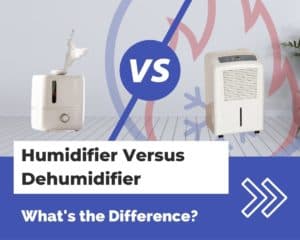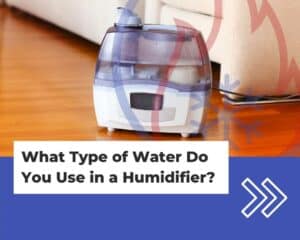HVAC Training Shop is reader-supported. As an Amazon Associate, I earn from qualifying purchases.
Maintaining the correct humidity level in your home can be a challenge, especially during the dry winter months. Fortunately, you can use a humidifier to help combat low moisture levels inside your home.
Ultrasonic humidifiers are a relatively new technology that allows you to humidify a space by using less energy than other types of humidifiers. In this article, I’ll discuss how ultrasonic humidifiers work and look at the benefits of using one.
How does an ultrasonic humidifier work?
An ultrasonic humidifier is a device that adds moisture to the air. It does this by using a metal or ceramic diaphragm that vibrates at high frequencies inside a pool of water.
As the diaphragm vibrates, microscopic water droplets are produced. A fan blows these droplets into your room where they evaporate to add humidity to the air.
How an ultrasonic humidifier works: a step-by-step process
- First, water from the tank travels through a demineralization cartridge (not all ultrasonic humidifiers have these) to remove mineral solids. The water travels through a pipe to the piezoelectric transducer’s diaphragm.
- Next, the piezoelectric transducer vibrates at high frequencies to create mist droplets that form inside the humidifier’s nebulizer chamber.
- Lastly, a circulation fan blows the mist droplets out of the humidifier, into the space that is to be humidified.

A closer look at the piezoelectric transducer
In an ultrasonic humidifier, the magic happens at the piezoelectric transducer.
A piezoelectric transducer is a device that converts electrical energy to high-frequency vibrations. The piezoelectric transducer connects to a diaphragm that vibrates against water. As the diaphragm vibrates against the water, mist droplets are created.
How ultrasonic atomization produces humidity
Ultrasonic atomization is the principle that ultrasonic humidifiers follow to create humidity. The principle is based on harnessing the power of two different effects:
- Cavitation bubble implosion. Tiny cavitation bubbles are produced when a vibrating surface changes its amplitude.
- Capillary wave theory. Rayleigh surface waves are created by the vibrating surface. The crests of these waves emit small mist droplets into the air.
By utilizing these two phenomena, ultrasonic humidifiers produce mist for long periods while using minimal amounts of energy.
To create humidity, the piezoelectric transducer vibrates against water. As the vibration speed increases to a rate where water particles cannot cling to the diaphragm, a momentary vacuum and compression occurs. In this instant, air bubbles form via the process of cavitation.
When cavitation occurs, broken capillary waves are created, and tiny mist droplets break above the surface of the water and dissipate into the air.
Ultrasonic humidifiers versus other types of humidifiers
There are many other types of humidifiers, each with its own advantages and disadvantages. These include evaporative humidifiers, steam humidifiers, and impeller humidifiers, to name a few.
Below, I’ll go over the differences between ultrasonic humidifiers and other types of humidifiers:
- Evaporative humidifier. The evaporative humidifier is one of the most common types of humidifiers. It works by blowing air through a saturated filter to add moisture to the air. They are easy to set up and don’t need the use of distilled water since they have a filter in them.
However, they can be quite noisy since they need a large fan to blow air. They also have ongoing maintenance costs since many of them require a filter change every few months.
- Steam humidifier. Steam humidifiers work by heating up water until it boils and produces steam. The steam blows into the room where it humidifies the air.
One advantage of a steam humidifier is that it works well in the wintertime to alleviate respiratory conditions that stem from cold dry air.
The main drawback of steam humidifiers is that they consume a lot of energy since they have to boil water. There are also safety concerns stemming from the use of a steam humidifier– they have heating elements inside them that get hot and can cause burns if mishandled.
- Impeller humidifier. The impeller humidifier has the most similar working principle to an ultrasonic humidifier. It works by spinning a disc that splashes water over a diffuser to create mist particles. The mist particles are then blown out of the humidifier to humidify a space.
The main drawback of impeller humidifiers is that they have lots of moving parts, so they tend to be quite noisy. Especially with the water splashing around. Like ultrasonic humidifiers, you’ll want to use distilled water in an impeller humidifier since they usually have no filter.
Benefits of using an ultrasonic humidifier
There are a few benefits that Ultrasonic humidifiers have over other types of humidifiers:
Low noise
Since ultrasonic humidifiers don’t rely on a large, noisy fan to add humidity to space, they are much quieter than other types of humidifiers.
While many ultrasonic humidifiers do have a small fan to blow the mist particles into your room, the fans in ultrasonic humidifiers are much smaller and don’t produce much noise when they run.
Low operation costs
While the initial cost of an ultrasonic humidifier can be quite a bit more than other types of humidifiers, the costs to operate ultrasonic humidifiers are much lower due to a couple of reasons:
- No filters to change. Ultrasonic humidifiers do not have any filters that you need to regularly change. This means that you won’t need to spend extra money every few months to replace a filter.
- Low electricity usage. Ultrasonic humidifiers use low amounts of electricity compared to other types of humidifiers. An ENERGY STAR report showed that ultrasonic humidifiers consume the least amount of electricity compared to cool mist and warm mist humidifiers.
Ultrasonic humidifiers use less electricity than other types of humidifiers. This is because they don’t have to heat up water or run a large fan to produce humidity. The piezoelectric transducer in an ultrasonic humidifier consumes a tiny amount of energy when compared to other humidifiers.
Safe to use
Ultrasonic humidifiers are among the safest type of humidifiers because they don’t use any heat to produce mist. Many people use ultrasonic humidifiers in their bedrooms or kids’ rooms since they pose minimal safety hazards.
The dos and don’ts when using an ultrasonic humidifier
- Do clean your ultrasonic humidifier on a regular basis. Cleaning your ultrasonic humidifier regularly will keep it running in tip-top shape. Cleaning also helps to prevent bacteria and mold build up inside your ultrasonic humidifier.
- Don’t use tap water in your ultrasonic humidifier. Since ultrasonic humidifiers lack filters to filter out minerals and contaminants, don’t use normal tap water to fill your humidifier.
Mineral deposits in your ultrasonic humidifier will damage your humidifier and can cause your humidifier to stop working.
- Do always use distilled water in your humidifier. Instead of tap water, use distilled water in your ultrasonic humidifier. Distilled water is treated to remove any dissolved minerals and particles. Dissolved minerals can impede the performance of your ultrasonic humidifier.
- Don’t place your ultrasonic humidifier in an enclosed area. Like other types of humidifiers, ultrasonic humidifiers don’t perform well if placed in a corner. They also don’t work in small areas where they can’t get proper airflow.
If your ultrasonic humidifier placed in an enclosed area, it won’t have enough “breathing room” to disperse moisture evenly throughout your area. It may also cause moisture to build upon the surfaces in your room.
- Do place your ultrasonic humidifier on a table or shelf. Placing your ultrasonic humidifier up high off the floor is usually a good idea. This helps it to prevent moisture accumulation around the base of your humidifier.
If you place your humidifier on the floor, then the mist droplets don’t have much time to evaporate before they fall onto the floor and accumulate as moisture.
If you place your ultrasonic humidifier on a shelf, ensure that you direct its mist stream away from any walls or ceilings. This helps to prevent moisture build-up on those surfaces.
- Do place your ultrasonic humidifier on a plastic tray. If you are having issues with moisture accumulation around the base of your ultrasonic humidifier, consider putting it on a plastic tray. Placing your humidifier on a plastic tray will catch moisture and prevent it from getting all over your floor.
How to clean an ultrasonic humidifier
Cleaning your ultrasonic humidifier is essential to keep it running as efficiently as possible. Cleaning is also necessary from a safety standpoint since it will help to keep your humidifier free of mold and bacteria build-up.
Cleaning your ultrasonic humidifier is relatively simple– especially compared to other types of humidifiers. This is because there are no filters or complicated parts to remove or change when cleaning an ultrasonic humidifier.
The cleaning routine of your ultrasonic humidifier may vary slightly. This depends on the manufacturer and model of your ultrasonic humidifier. Generally, to clean your ultrasonic humidifier, follow these steps:
- Turn off and unplug your humidifier. This is a very important first step because you don’t want your humidifier connected to any sources of power that can harm you.
- Remove the mist nozzle and tank (if applicable). Some ultrasonic humidifiers have a removable nozzle where the mist comes out from. It is important to remove this part and clean it separately from the rest of the humidifier. Some ultrasonic humidifiers also have a removable tank that you need to clean separately.
- Empty the tank. Discard all the water from the humidifier’s tank. If the humidifier has a removable tank, there will sometimes be a bit of water leftover in the humidifier’s basin that needs to be dumped out as well.
- Use vinegar to clean the tank. Use a vinegar solution to clean the interior of the humidifier’s tank. Soak tank or basin with vinegar for 30 minutes to remove any mineral build-up, if needed.
- Rinse the tank and basin out with distilled water. After you clean the humidifier with vinegar, rinse the vinegar solution out with distilled water. You can also use tap water in this instance since it won’t be enough to cause any harm (but we like to use distilled water anyway).
- Allow the humidifier to dry. It is very important to allow the humidifier to completely dry out before using it again. Layout the disassembled parts of your humidifier in a drying rack to let them dry for a few hours.
After the parts are dry, inspect them to ensure that they are thoroughly cleaned and there is not any residual mineral build-up.
- Reassemble the humidifier and start it back up. After the parts are clean and dry, put the humidifier back together and add distilled water to its tank. Plugin the humidifier and turn it back on, ensuring that it returns to normal operation and everything works properly.



